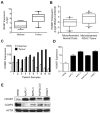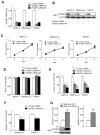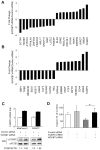HOXB7 promotes invasion and predicts survival in pancreatic adenocarcinoma
- PMID: 22914903
- PMCID: PMC3867310
- DOI: 10.1002/cncr.27725
HOXB7 promotes invasion and predicts survival in pancreatic adenocarcinoma
Abstract
Background: The homeobox gene HOXB7 is overexpressed across a range of cancers and promotes tumorigenesis through varying effects on proliferation, survival, invasion, and angiogenesis. Although published microarray data suggest HOXB7 is overexpressed in pancreatic ductal adenocarcinoma (PDAC), its function in pancreatic cancer has not been studied.
Methods: HOXB7 message and protein levels were examined in PDAC cell lines and patient samples, as well as in normal pancreas. HOXB7 protein expression in patient tumors was determined by immunohistochemistry and correlated with clinicopathologic factors and survival. The impact of HOXB7 on cell proliferation, growth, and invasion was assessed by knockdown and overexpression in PDAC cell lines. Candidate genes whose expression levels were altered following HOXB7 knockdown were determined by microarray analysis.
Results: HOXB7 message and protein levels were significantly elevated in PDAC cell lines and patient tumor samples relative to normal pancreas. Evaluation of a tissue microarray of 145 resected PDACs found high HOXB7 protein expression was correlated with lymph node metastasis (P = .034) and an independent predictor of worse overall survival in multivariate analysis (hazard ratio = 1.56, 95% confidence interval = 1.02-2.39). HOXB7 knockdown or overexpression in PDAC cell lines resulted in decreased or increased invasion, respectively, without influencing proliferation or cell viability.
Conclusions: HOXB7 is frequently overexpressed in PDAC, specifically promotes invasive phenotype, and is associated with lymph node metastasis and worse survival outcome. HOXB7 and its downstream targets may represent novel clinical biomarkers or targets of therapy for inhibiting the invasive and metastatic capacity of PDAC.
Copyright © 2012 American Cancer Society.
Conflict of interest statement
CONFLICT OF INTEREST DISCLOSURE
The authors made no disclosure.
Figures




Similar articles
-
HOXB7 mRNA is overexpressed in pancreatic ductal adenocarcinomas and its knockdown induces cell cycle arrest and apoptosis.BMC Cancer. 2013 Oct 2;13:451. doi: 10.1186/1471-2407-13-451. BMC Cancer. 2013. PMID: 24088503 Free PMC article.
-
Increased CDC20 expression is associated with pancreatic ductal adenocarcinoma differentiation and progression.J Hematol Oncol. 2012 Apr 4;5:15. doi: 10.1186/1756-8722-5-15. J Hematol Oncol. 2012. PMID: 22475564 Free PMC article.
-
Linc00675 is a novel marker of short survival and recurrence in patients with pancreatic ductal adenocarcinoma.World J Gastroenterol. 2015 Aug 21;21(31):9348-57. doi: 10.3748/wjg.v21.i31.9348. World J Gastroenterol. 2015. PMID: 26309360 Free PMC article.
-
Levels of HOXB7 and miR-337 in pancreatic ductal adenocarcinoma patients.Diagn Pathol. 2014 Mar 18;9:61. doi: 10.1186/1746-1596-9-61. Diagn Pathol. 2014. PMID: 24641834 Free PMC article.
-
Overexpression of APC11 predicts worse survival in lung adenocarcinoma [Corrigendum].Onco Targets Ther. 2019 May 2;12:3361-3362. doi: 10.2147/OTT.S212589. eCollection 2019. Onco Targets Ther. 2019. PMID: 31118687 Free PMC article. Review. No abstract available.
Cited by
-
HOXB7 as a promising molecular marker for metastasis in cancers: a meta-analysis.Onco Targets Ther. 2016 May 6;9:2693-9. doi: 10.2147/OTT.S104000. eCollection 2016. Onco Targets Ther. 2016. PMID: 27274269 Free PMC article.
-
The prognostic value of homeobox B7 expression in patients with hepatocellular carcinoma.Int J Clin Exp Pathol. 2019 Jul 1;12(7):2682-2690. eCollection 2019. Int J Clin Exp Pathol. 2019. PMID: 31934098 Free PMC article.
-
Proteins associated with pancreatic cancer survival in patients with resectable pancreatic ductal adenocarcinoma.Lab Invest. 2015 Jan;95(1):43-55. doi: 10.1038/labinvest.2014.128. Epub 2014 Oct 27. Lab Invest. 2015. PMID: 25347153 Free PMC article.
-
PDX1 dynamically regulates pancreatic ductal adenocarcinoma initiation and maintenance.Genes Dev. 2016 Dec 15;30(24):2669-2683. doi: 10.1101/gad.291021.116. Genes Dev. 2016. PMID: 28087712 Free PMC article.
-
Upregulation of HOXB7 promotes the tumorigenesis and progression of gastric cancer and correlates with clinical characteristics.Tumour Biol. 2016 Feb;37(2):1641-50. doi: 10.1007/s13277-015-3948-3. Epub 2015 Aug 26. Tumour Biol. 2016. PMID: 26307396
References
-
- American Cancer Society. Cancer Facts & Figures 2010. Atlanta, GA: American Cancer Society; 2010.
-
- Stathis A, Moore MJ. Advanced pancreatic carcinoma: current treatment and future challenges. Nat Rev Clin Oncol. 2010;7:163–172. - PubMed
-
- Neoptolemos JP, Stocken DD, Bassi C, et al. Adjuvant chemotherapy with fluorouracil plus folinic acid vs gemcitabine following pancreatic cancer resection: a randomized controlled trial. JAMA. 2010;304:1073–1081. - PubMed
-
- Hanahan D, Weinberg RA. Hallmarks of cancer: the next generation. Cell. 2011;144:646–674. - PubMed
-
- Mihaljevic AL, Michalski CW, Friess H, Kleeff J. Molecular mechanism of pancreatic cancer--understanding proliferation, invasion, and metastasis. Langenbecks Arch Surg. 2010;395:295–308. - PubMed
Publication types
MeSH terms
Substances
Grants and funding
LinkOut - more resources
Full Text Sources
Medical
Research Materials

